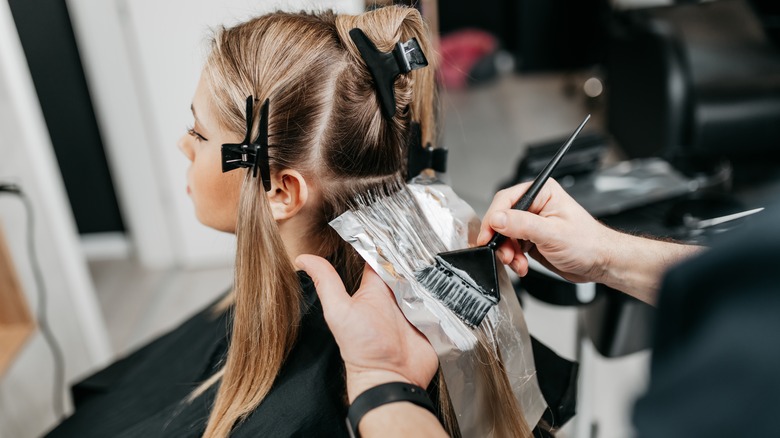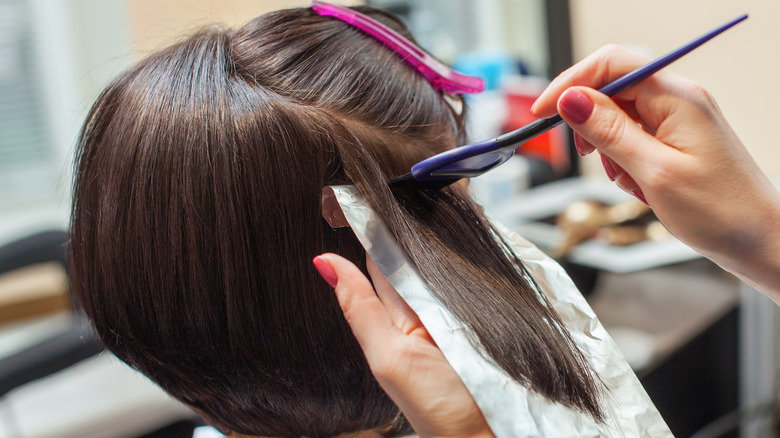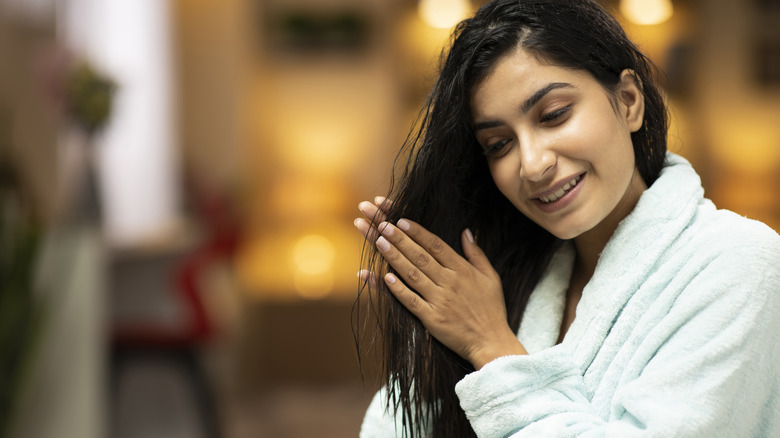Your Guide To Hair Coloring Method Foilyage & Its Benefits
It's the season of hair foilyage. You may have already wondered what the difference is between babylights, balayage, and highlights, but now another technique has entered the chat. According to Byrdie, the foilyage method uses balayage and traditional foiling highlights to create a brighter and more defined result, while still having that subtle, painted-on effect. In other words, foilyage is the perfect way to subtly reinvent your hair without going too overboard with the color.
As hair colorist Barney Martin explained, autumn is an especially good time to experiment with highlights and lowlights. "We are moving away from time spent at the beach and opting for a polished and seamless colour refresh," he told Elle Australia. That's where foilyage comes in, especially if your hair is naturally darker. It plays with the caramel brown tones that are perfectly reflected in the color of trees, winter scarves, and dark lipstick. When the goal is to add warmth and depth to your hair, foilyage is here to save the day.
The foilyage process
Like many lightening techniques, foilyage begins with a hairstylist sectioning the hair in parts. Each section of hair is then painted with lightener like bleach, wrapped in foil, and left to develop for approximately two hours (it may differ from stylist to stylist).
Now, you may be wondering: Wait, isn't that just highlights? Yes and no. For highlights, a hairstylist may apply the dye from root to tip in a straight up and down fashion before leaving it to develop, according to Glamour UK. Foilyage, however, still follows that same hand-painted approach as balayage, where the color isn't necessarily applied vertically over pieces of the same size. Instead, it involves painting lightener on tiny sections across various parts of the head, with the pieces becoming thicker toward the ends for gradient-like effect.
Since this involves a lot of precision, the process can be quite time consuming, depending on your hair length. Expect to be in the chair anywhere from one to 4 hour or more if you're trying to lighten really dark hair. Once your hair has been lightened, your stylist will likely go in with a toner to complete the dye process. Through the use of hot tools, your stylist may then use heat to solidify the dye while giving hair a natural shine. Nearing the end of the process, use a bonding or finishing oil to polish off the hair to ensure your new do looks healthier than ever before.
Choosing between balayage and foilyage
Although they may seem similar, there's a few important differences between receiving a balayage vs. foilyage treatment. According to InStyle, a balayage provides a subtle, sun-kissed appearance to the hair, while a foilyage is brighter and more consistent, like a regular foil highlight. Balayage is a common choice for blondes and light brunettes who want a subtle lift in tones closer to their natural hair. Foilyage, on the other hand, can help those with dark hair achieve the pop of color they desire. This is because wrapping the hair in foil allows it to saturate in the bleach, making it easier for the color to lighten. With a regular balayage, the free-form painting technique only coats the top part of the hair, so it takes longer for the color change, especially on dark hair. "By isolating the lightener in a foil, you can get more lift than you would with balayage," celebrity hair colorist George Papanikolas told Byrdie. "This allows darker hair to lift to a pale blonde giving a more uniform finish." But, because it is still painted on like balayage, the placement of the color is still seamless.
As a result, foilyage can offer a blend that — while more distinct in color — still creates a natural appearance that may appease dark-haired clients who aren't into the dramatic two-tone hair or tiger stripe look. You'll want to make sure your hair stylist is experienced with the treatment, since it requires delicate treatment of the roots to ensure hair is not damaged. Depending on the goals you've set for your hair, both treatments will achieve different results.
Equally important to consider is cost. Where traditional highlighting processes can cost from as little as $110, the average rate for foilyage ranges from $250 to $400 per session, depending on the length of your hair. However, since the style requires minimal touch-ups, some might consider this an investment.
Maintaining foilyage hair
The most important question of all: How do you maintain foilyaged hair? The answer may be more simple than you expect. Per celebrity colorist Ryan Pearl, purple shampoo is out and hair gloss is in, explaining that purple shampoo is likely to flatten out the dyed color and leave hair feeling like sandpaper. "Glosses give a more customized color and a conditioning benefit to the hair, too," he told InStyle, in addition to refreshing the color and hydrating hair strands to create a healthy shine.
It's also essential not to over wash hair, as regular shampoos and conditioners can rid the hair of its new color. Instead, opt for a color-safe shampoo that can maintain hair dye while effectively washing the hair and scalp. If you're physically active, wearing a colorproof hair masque can help soften the hair while protecting the scalp from sweat, dirt, and bacteria. Before using heat tools to style the hair, apply a strengthening oil and heat protectant. Try to wear hair naturally more often — after all, showing off your highlights is a right of passage.



